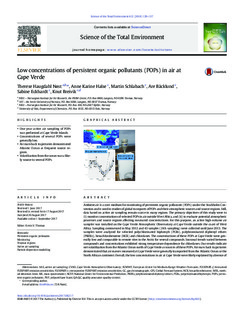| dc.contributor.author | Nøst, Therese Haugdahl | |
| dc.contributor.author | Halse, Anne Karine | |
| dc.contributor.author | Schlabach, Martin | |
| dc.contributor.author | Bäcklund, Are | |
| dc.contributor.author | Eckhardt, Sabine | |
| dc.contributor.author | Breivik, Knut | |
| dc.date.accessioned | 2017-11-06T11:13:43Z | |
| dc.date.available | 2017-11-06T11:13:43Z | |
| dc.date.created | 2017-09-02T15:44:32Z | |
| dc.date.issued | 2018 | |
| dc.identifier.citation | Nøst, T. H., Halse, A. K., Schlabach, M., Bäcklund, A., Eckhardt, S., & Breivik, K. (2018). Low concentrations of persistent organic pollutants (POPs) in air at Cape Verde. Science of The Total Environment, 612, 129-137. doi:10.1016/j.scitotenv.2017.08.217 | nb_NO |
| dc.identifier.issn | 0048-9697 | |
| dc.identifier.uri | http://hdl.handle.net/11250/2464192 | |
| dc.description.abstract | Ambient air is a core medium for monitoring of persistent organic pollutants (POPs) under the Stockholm Convention and is used in studies of global transports of POPs and their atmospheric sources and source regions. Still, data based on active air sampling remain scarce in many regions. The primary objectives of this study were to (i) monitor concentrations of selected POPs in air outside West Africa, and (ii) to evaluate potential atmospheric processes and source regions affecting measured concentrations. For this purpose, an active high-volume air sampler was installed on the Cape Verde Atmospheric Observatory at Cape Verde outside the coast of West Africa. Sampling commenced in May 2012 and 43 samples (24 h sampling) were collected until June 2013. The samples were analyzed for selected polychlorinated biphenyls (PCBs), polybrominated diphenyl ethers (PBDEs), hexachlorobenzene (HCB) and chlordanes. The concentrations of these POPs at Cape Verde were generally low and comparable to remote sites in the Arctic for several compounds. Seasonal trends varied between compounds and concentrations exhibited strong temperature dependence for chlordanes. Our results indicate net volatilization fromthe Atlantic Ocean north of Cape Verde as sources of these POPs. Air mass back trajectories demonstrated that air masses measured at Cape Verdewere generally transported fromthe Atlantic Ocean or the North African continent. Overall, the low concentrations in air at Cape Verde were likely explained by absence of major emissions in areas from which the air masses originated combined with depletion during long-range atmospheric transport due to enhanced degradation under tropical conditions (high temperatures and concentrations of hydroxyl radicals). | nb_NO |
| dc.language.iso | eng | nb_NO |
| dc.relation.uri | https://authors.elsevier.com/sd/article/S0048-9697(17)32215-5 | |
| dc.rights | Navngivelse 4.0 Internasjonal | * |
| dc.rights.uri | http://creativecommons.org/licenses/by/4.0/deed.no | * |
| dc.title | Low concentrations of persistent organic pollutants (POPs) in air at Cape Verde | nb_NO |
| dc.type | Journal article | nb_NO |
| dc.type | Peer reviewed | nb_NO |
| dc.description.version | publishedVersion | nb_NO |
| dc.rights.holder | © 2017 The Author(s). Published by Elsevier B.V. | nb_NO |
| dc.source.pagenumber | 129-137 | nb_NO |
| dc.source.volume | 612 | nb_NO |
| dc.source.journal | Science of the Total Environment | nb_NO |
| dc.identifier.doi | 10.1016/j.scitotenv.2017.08.217 | |
| dc.identifier.cristin | 1490539 | |
| dc.relation.project | Norges forskningsråd: 213577 | nb_NO |
| cristin.unitcode | 7460,60,0,0 | |
| cristin.unitcode | 7460,52,0,0 | |
| cristin.unitcode | 7460,57,0,0 | |
| cristin.unitname | Miljøkjemi | |
| cristin.unitname | Måle- og instrumentteknologi | |
| cristin.unitname | Atmosfære og klima | |
| cristin.ispublished | true | |
| cristin.fulltext | original | |
| cristin.qualitycode | 2 | |

